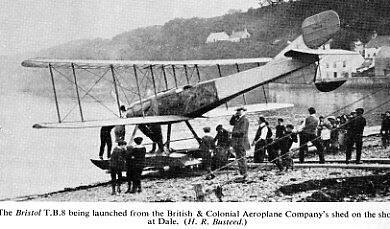Dale Point
Note: This map only shows my guess as to where this site was. Does the nearby Point Farm offer a clue? If anybody can kindly offer more information, this advice will be most welcome.
DALE POINT: Early experimental seaplane facility
Period of operation: 1912 and 1913 only?
NOTES: In his book British Built Aircraft Vol.5 Ron Smith makes this entry: “Dale was used as an early experimental base for British and Colonial Aeroplane Co. Ltd waterborne aircraft during 1912 and 1913. The Bristol TB 8 was flown successfully here in 1913, after trials of the novel, but unsuccessful, Bristol Burney X.2 Hydroplane.”
Note: These four pictures are all scanned from, British Aviation - The Pioneer Years. The fourth picture is attributed to H R Busteed.
In his excellent book, British Aviation - The Pioneer Years, by Harald Penrose first published in 1967, he adds much more information:
"Certainly the aircraft industry was not afraid of tackling complex problems, even though some solutions were hopeful guesses rather than exact science. Typical was the new Burney X.2, now completed at Filton. Although Forlanini's work on hydrofoils was consulted, no tank tests on 'hydropeds' were made, because it seemed easier to comprehend full-scale trials. Construction had occupied only two months since the moment in February when Frank Barnwell scrapped the original biplane conception and turned to monoplane. As a flying machine it was visibly inferior to the latest Prier-Dickson-Coanda designs."
"With all possible secrecy, X.2 was taken to Avonmouth on May 9th and towed on a lighter across the Severn to the secluded inlet of Dale on the Milford Haven estuary. A 22-year old Australian, tough Harry Busteed, was selected as pilot for the trials. He had been one of the enthusiasts attending the great initial sales mission Sir George White sent to Australia in his early programme of selling Boxkites. As a result, Busteed was fired with the idea of making flying his career, and 'played about with an Anzani Blériot and a Wright in Australia in the latter part of 1911, but as the results were disappointing I decided to come to England and picked up Hawker, Harrison and Kauper, who were keen to have a look around."
As we now know, Hawker went on to make his name as one of the iconic brands of aircraft in British aviation history. Taking over from Sopwith.
"On arriving here I went straight to the Bristol School at Larkhill and learned to fly - the others to various jobs mostly concerned with motor-cars. Later I arranged for Harrison to fly with me as instructor. Hawker and Kauper joined Tom Sopwith, who presently taught them to fly."
However, getting back to the X.2 trouble soon began. I won't bother with the details, it was all pretty much a complete waste of effort, time and expense. The X.2 did become airborne under tow it seems, just once, but. almost immediately after lifting off at far too great an angle, it stalled and crashed.
We'd love to hear from you, so please scroll down to leave a comment!
Leave a comment ...
Copyright (c) UK Airfield Guide



















